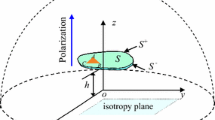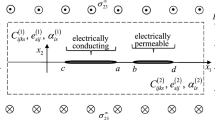Abstract
A solution is presented for a class of two-dimensional electroelastic branched crack problems. Explicit Green's function for an interface crack subject to an edge dislocation is developed using the extended Stroh formulation allowing the branched crack problem to be expressed in terms of coupled singular integral equations. The integral equations are obtained by the method that models a kink as a continuous distribution of edge dislocations, and the dislocation density function is defined on the line of the branch crack only. Competition between crack extension along the interface and kinking into the substrate is investigated using the integral equations and the maximum energy release rate criterion. Numerical results are presented to show the effect of electric field on the path of crack extension.
Similar content being viewed by others

References
Evans AG, Dalgleish BJ, He MY, Hutchinson JW. On crack path selection and the interface fracture energy in bimaterial systems.Acta Metall, 1989, 37: 3249–3254
Sih GC. Strain energy factors applied to mixed mode crack problems.Int J Frac, 1974, 10: 305–321
Hayashi K, Nemat-Nasser S. Energy-release rate and crack kinking under combined loading.Journal of Applied Mechanics, 1981, 48: 520–524
He MY, Evans AG, Hutchinson JW. Interface cracking phenomena in constrained metal layers.Acta Materialia, 1996, 44: 2963–2971
Lo KK. Analysis of branched cracks.Journal of Applied Mechanics, 1978, 45: 797–802
Hayashi K, Nemat-Nasser S. On branched, interface cracks.Journal of Applied Mechanics, 1981, 48: 529–533
He MY, Hutchinson JW. Kinking of a crack out of an interface.Journal of Applied Mechanics, 1989, 56: 270–278
Miller GR, Stock WL. Analysis of branched interface cracks between dissimilar anisotropic media.Journal of Applied Mechanics, 1989, 56: 844–849
Hutchinson JW, Suo Z. Mixed mode cracking in layered materials. In: Hutchinson JW, Wu TY eds,Advances in Applied Mechanics, 1992, 29: 63–191
Wang TC, Shih CF, Suo Z. Crack extension and kinking in laminates and bicrystals.Int J Solids Struct, 1992, 29: 327–344
Atkinson C, Bastero C, Sanchez MI. Prediction of branching (or relaxation) angle in anisotropic or isotropic elastic bimaterials with rigid substrate.Int J Frac, 1994, 67: 231–261
Stroh AN. Dislocations and cracks in anisotropic elasticity.Phil Mag, 1958, 7: 625–646
Barnett DM, Lothe J. Dislocations and line charges in anisotropic piezoelectric insulators.Phys Stat Sol (b), 1975, 67: 105–111
Chung MY, Ting TCT. Piezoelectric solid with an elliptic inclusion or hole.Int J Solids Struct, 1996, 33: 3343–3361
Yu SW, Qin QH. Damage analysis of thermopiezoelectric properties: Part I—crack tip singularities.Theoretical and Applied Fracture Mechanics, 1996, 25: 263–277
Qin QH. A new solution for thermopiezoelectric solid with an insulated elliptic hole.Acta Mechanica Sinica, 1998, 14: 157–170
Suo Z. Singularities, interfaces and cracks in dissimilar anisotropic media.Proc R Soc Lond, 1990, A427: 331–358
Suo Z, Kuo CM, Barnett DM, Willis JR. Fracture mechanics for piezoelectric ceramics.J Mech Phys Solids, 1992, 40: 739–765
Qin QH, Mai YW. Crack growth prediction of an inclined crack in a half-plane thermopiezoelectric solid.Theoretical and Applied Fracture Mechanics, 1997: 26: 185–191
Muskhelishvili NI. Some Basic Problems of Mathematical Theory of Elasticity. Groningen, Holland: NVP Noordhoff Ltd, 1953
Qin QH, Mai YW. Thermoelectroelastic Green's function and its application for bimaterial of piezoelectric materials.Archive of Applied Mechanics, 1998, 68: 433–444
Erdogan F, Gupta GD. On the numerical solution of singular integral equations.Q Appl Mathe, 1972, 32: 525–534
Park SB, Sun CT. Effect of electric field on fracture of piezoelectric ceramics.Int J Frac, 1995, 70: 203–216
Qin QH, Yu SW. An arbitrarily-oriented plane crack terminating at the interface between dissimilar piezoelectric materials.Int J Solids Struct, 1997, 34: 581–590
Author information
Authors and Affiliations
Additional information
The work was supported by the Australian Research Council through a Queen Elizabeth II fellowship and by the Australian Academy of Science through the J.G. Russell Award.
Rights and permissions
About this article
Cite this article
Qinghua, Q. Crack kinking in piezoelectric materials. Acta Mech Sinica 14, 339–352 (1998). https://doi.org/10.1007/BF02486872
Received:
Issue Date:
DOI: https://doi.org/10.1007/BF02486872



